Dear Friends,
I’m thinking a lot about how complex holidays have become or always were. We have reframed these days-off into rituals that have little or nothing to do with the origin stories. My favorite might be David Sedaris’ hysterical French class conversation about Easter, Jesus Shaves, in which a group of students share neither a common language nor cultural traditions that can even begin to explain how a man raises from the dead in order to absolve our sins and a rabbit who brings chocolate shaped like small eggs. I won’t venture into the formerly known as Columbus Day, St. Patrick’s Day, Thanksgiving, holidays that are now mostly about parades and eating. Same with the fourth of July. For years my family celebrated on Diamond Lake in Cassopolis, Michigan, my dad’s favorite spot. It did cross my mind that it would be interesting or at least amusing to swim from party boat to party boat asking: does anyone know what we are celebrating? Or an even better question would be: Wow, aren’t you glad that we broke from Great Britain all of those years ago? This party would suck if we reported to a King.
And speaking of complex, as I thought about this week’s message to all of you, I conjured an image of Elkanah Watson’s portrait, the one painted by Copley in 1782.
You’ve been with me long enough to know that I like holidays. My Easter post was a bunny on top of a car. I wrote about Mother’s Day twice, here and here. Well, yesterday I sat and thought about which paintings in my past would resonate on July 4, and eerily I remembered the teeny American flag on the ship in the background of Watson’s portrait. The mind works in mysterious ways and I can only say that a day of hiking and swimming brought me such solace that the corner of my brain where that picture was stored opened up.
Looking first, as always, Watson is dressed in a striking red coat, embellished waistcoat, holding his hat in his right hand and papers in his left, leaning on a grand column. He wears a tightly rolled and powdered wig, and gazes off into the distance, rosy in the cheeks, sharp nose, a look of intention and authority. He’s young, if his unlined face and posture are telling. The table next to him is covered with more papers, folded, ear-marked, a ledger book and quill pen and ink well convey that business is to hand. And out the window, under a billowing dark green curtain is a double-masted boat at full sail with an American flag flying up top.
Here’s what I know: he is young, 24 years young, an American merchant from Plymouth, Massachusetts, who took a position five years before with John Brown of Providence, Rhode Island. Yes, the John Brown, whose family founded Brown University with riches gained from the slave trade. Elkanah--whose name derives from Hebrew tradition with a meaning of “God has Bought”--was charged by Brown with the task of taking missives and dispatches to Benjamin Franklin in Paris during the Revolution. Now living in London, Watson’s red coat, floral embroidered vest, and posh wig portray him as an English gentleman of authority. He contacted Copley, then in London too, in 1782 for a portrait that would record his ascendancy in business and in life. Watson kept a diary for his entire life and wrote that Copley had finished the portrait “in most admirable style” but kept the background blank because both anticipated the end of the Revolutionary War. Once news of the end of combat reached them, so the story goes, Copley returned to the picture and Watson himself “designed to represent a ship, bearing to America the intelligence of the acknowledgement of independence, with a sun just rising upon the stripes of the Union, streaming from her gaff.” Watson said also “This was, I imagine, the first American flag hoisted in old England.”
Yet, what independence? And for whom? And how conflicted that Watson stands in London, dressed like a wealthy Englishman? And we know his business, with one of the letters clearly addressed to his employer, John Brown. The Princeton Art Museum, where the picture hangs (or will hang again after the museum is renovated) has engaged in a project of interrogation and their online text is written by a student who states what is not obvious: “Watson’s wealth stemmed directly from a trade system based on slavery. This reality is completely absent from this portrait, illustrating the erasure of slavery and the black body from the colonial and revolutionary narrative.” Makes me wonder just what or who is on that ship bearing the American flag.
Take a walk
More questions than answers always makes me want to take a walk, today another hike in Fahnestock Park, where I’m so intrigued by fungi and the lush green of summer. We try to switch up the routes, but there is something wonderful about taking the same path and seeing what changed week to week. And bumping into hikers on the Appalachian Trail, walkers in nature all the way from the Georgia starting point and months into a very long and wonderful journey by foot to Mount Katahdin in Maine.
And onward
For next week, I’ll have another picture, a secret for now related to a new project for me, shhhhh. Stay tuned, I’ll be able to share more next Sunday.
Until then, keep walking and looking, slowly and with curiosity and courage,
Carrie





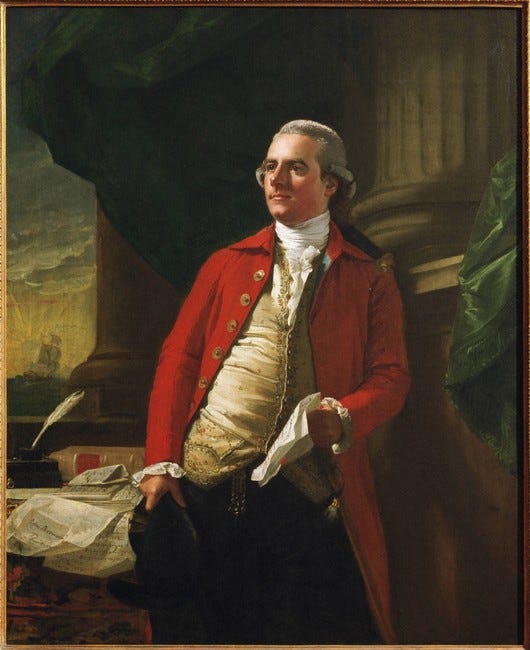

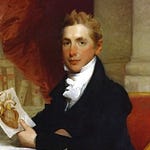



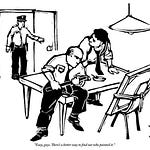
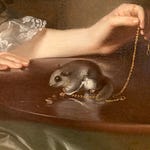
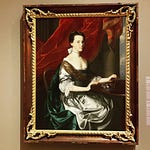
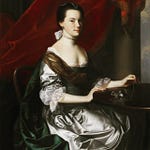
Share this post